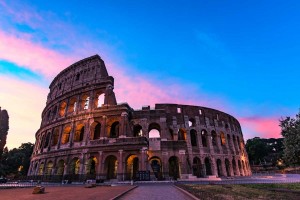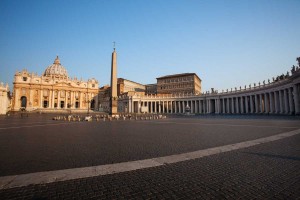
©Bigstock.com/Vicheien Petchmai
Let’s be honest, what else can we tell you about Rome you don’t already know? Italy’s capital, metropolis, breeding ground of the Roman Empire, home of some of the world’s most glorious sights, rich in amazing history, cultural monuments and some of the most important pieces of art in existence today. Naturally, the historic centre and all extraterritorial properties of the Holy See are part of the UNESCO World Heritage list. Why? It’s not like we really have to explain why, is it? Instead, let us tell what there is to see, and which highlights are an absolute must for your next visit.
The growing World Heritage Site
Let’s not go over the history of Romulus and Remus again (if you really want to, read on here) and instead get this thing on the road. Did you know that the original UNESCO World Heritage Site Rome was much smaller? Declared in 1980, Rome was only the second Italian site to receive this honour (one year after the rock drawings in Valcamonica and at the same time as Santa Maria delle Grazie in Milan). The extraterritorial properties of the Holy See were only gradually declared UNESCO World Heritage Site in 1984 and 1990. Nowadays, the protected historic centre of Rome encompasses a total area of 1,446.2 ha plus another 38.9 ha of Holy See properties.
Over 25,000 scenic, historic and archaeological sites, contained within the Aurealian Walls and the Gianicolesi Walls, await you. Here are some of Rome’s major highlights for you at a glance.
Ancient Rome
Being the breeding ground of the Roman Empire – nomen est omen, if you like – Rome managed to retain its ancient charm to this day. Monuments of the erstwhile world empire still dominate the cityscape, some of which are in pretty great shape. Where to start, you wonder? Let’s try the following:
- Roman Forum: Dating back to the 7th century BC, the Etruscan king Lucius Tarquinius Priscus added a swampy valley to his city plans. The Roman Empire set up the centre of city life here. Today’s archaeological site encompasses various religious and secular buildings, such as remains of ancient temples and basilicas. Enhanced by the Imperial Fora, you can fully immerse yourself into Roman cultural history.
- Mausoleums: Two of the numerous mausoleums of the old Roman city stick out. Castel Sant’Angelo was originally built as a last resting place for Hadrian and his successors. Converted into a fortified castle by the popes, it has been housing a museum since the early 20th The Mausoleum of Augustus, where the namesake Emperor Augustus and many other famous Romans are buried, is currently being renovated and should be open again for the public in 2019.
- Pantheon: One of the best-conserved buildings of ancient Rome is actually based on a small temple dating back to pre-Christian times. The Pantheon has long since surpassed these modest beginnings and even held the record for the largest cupola in the world for 1,700 years. Used as a church nowadays, it saw famous artist being buried inside it in the Renaissance. Among them are Peruzzi and Raphael, who was laid to rest in an ancient Roman sarcophagus.
- Victory columns: Construction of monumental victory columns began in the 2nd century BC. Many of them still rise high into the sky. Among the most famous of their kind are Trajan’s Column, on which all following monuments were based, and the nearly 30-m-high Column of Marcus Aurelius with its impressive picture relief.
- Colosseum: What would Rome be without its Colosseum? The world’s biggest amphitheatre used to set the stage for the “bread and circuses” philosophy of Roman emperors. To this day, its ruins emanate the peak of ancient architecture. According to calculations, up to 50,000 spectators flocked through the 80 entrances to witness bloodthirsty spectacles and daredevil chariot races. Nowadays, the Colosseum acts as a venue of concerts and events in historic ambiance.
The city squares
Forum aside, many other city squares are part of the UNESCO World Heritage Site that is Rome. They are home to rather legendary sights and monuments steeped in history. Why not head to:
- Piazza Navona: A whopping three spectacular fountains including Fontana dei Quattro Fiumi, likely Gian Lorenzo Bernini’s most famous work, await you here.
- Largo di Torre Argentina: Systematic excavations in the Pigna district during the 1920s unearthed the ruins of countless temples.
- Piazza Venezia: Named after Palazzo Venezia, this square is located on the foot of the Capitoline Hill. This main transport nodal point is known for, among other things, the imposing Monumento Vittorio Emanuele II.
- Piazza di Trevi: As the name suggests, this square is home to the Trevi Fountain, likely the most important and best-known fountain of the city. The artful transition from late baroque to Classicism continues to impress to this very day.
- Piazza del Popolo: This square already used to serve as the entrance to Rome in ancient days. It now sees the twin churches Santa Maria del Popolo and Santa Maria dei Miracoli rise high into the sky.
- Campo de’Fiori: Located around a statue of the philosopher Giordano Bruno, you come across one of the city’s most beautiful markets with its eponymous floridity.
- Piazza di Spagna:.. Spanish… Spanish Steps! The popular meeting place for tourists originally lead to the Spanish embassy to Vatican City. Back in the day, it was possible to make foreigners without a stay permit serve in the military. No need to worry, though, as this is no longer the case.
Vatican City

©Bigstock.com/TatyanaGI
Technically, Vatican City has been a UNESCO World Heritage Site in its own right since 1984. It is the only state in the world to be featured on this list in its entirety. There’s not much left to say you don’t already know about St. Peter’s Square and St. Peter’s Basilica. Something that’s frequently forgotten, however, are the Vatican Museums, home to the papal art collections. The pope’s Apostolic Palace with the Sistine Chapel wows with a highly different selection of masterpieces ranging from ancient Egypt to contemporary art.
Properties of the Holy See
They are frequently overlooked when listing the magnificent Vatican buildings and were only given the status of World Heritage Site in 1990 after the second territorial extension. Among the extraterritorial properties are:
- Basilica of Saint Paul Outside the walls: San Paolo fuori le Mura got its name due to being located outside the Aurelian Walls. Heavily damaged by a fire in the 19th century and reconstructed by Luigi Poletti, the grave of Paul the Apostle was rediscovered here in 2006.
- Santa Maria Maggiore: Santa Maria Maggiore saw several reconstructions and additions on ancient foundations during its changeful history. Let this architectural masterpiece with the cupolas and the imposing bell tower put you under its spell.
- San Giovanni in Laterano: The Archbasilica of St. John Lateran was Rome’s first cathedral. Its comparatively simple look hides monumental size, opulently vested by baroque restoration works.
- Palazzo di Propaganda Fide: Spanish Steps aside, this palace is the second highlight of Piazza di Spagna. This epitome of Roman baroque art houses a Jesuit order and , thus, is not open to the public.
- Palazzo della Cancelleria: Rome’s first Renaissance palace used to serve as a seat of government to the Papal States. The ostentatious Sala dei Cento Giorni hides behind the main façade made of travertine stones.
Rome is simply amazing, and we could go on like this forever. Find countless additional sights and tour suggestions for your next stay in Rome on ZAINOO. You absolutely should set aside several days for your next visit to the Eternal City to at least get an approximate idea of the city’s glory and splendour. We wish you lots of fun and safe travels!